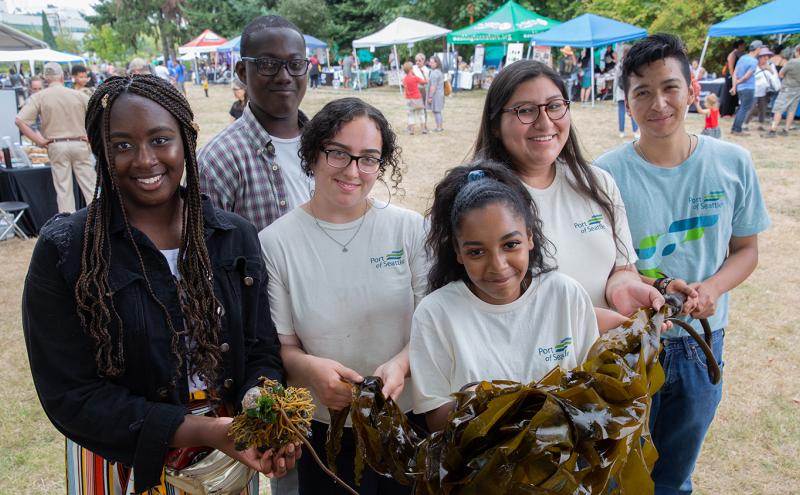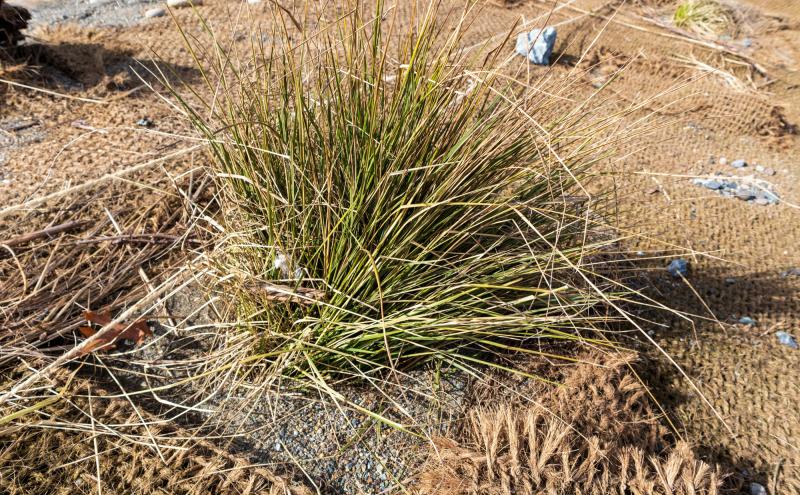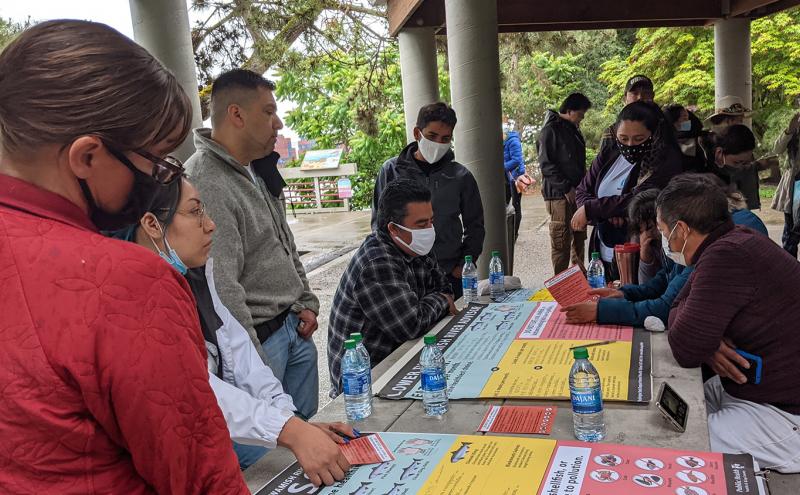
Seafood is a nutritious part of many diets, packed with high-quality protein and vitamins, minerals, and fatty acids that offer significant health benefits. But depending on where your seafood comes from, it’s not always safe to eat. Seafood from fish and shellfish that spend time in contaminated waters can contain chemicals that are harmful to human health. To reduce fisher and community risks, state and local health departments monitor seafood and provide information and advisories at multiple sites across the state to alert fishers to specific health risks.
According to the Washington State Department of Health, resident fish, shellfish, or crab from the Lower Duwamish River that flows though South Seattle are not safe to eat, as they spend their whole lives in the river. Salmon caught from the river can be consumed in recommended amounts because they spend a shorter time in the river.
To protect the community’s health, warning advisories conveying this information are displayed at fishing locations along the river, including Port-owned parks. A recent Environmental Protection Agency (EPA) study found that this critical information has not effectively reached the more than 20 ethnic groups who currently fish in popular spots on the Duwamish River and who speak little to no English.
Unaware of the health risks, fishers from Asian, Pacific Islander (API), and Latino immigrant communities were catching, eating, and sharing the contaminated seafood from the river. To address this, the Fun to Catch, Toxic to Eat Program launched in 2017 through a cooperative agreement between the EPA and a partnership with Public Health – Seattle & King County. The program educates the community — especially pregnant women, nursing moms, and young children — about the risks of eating seafood caught in the Lower Duwamish River Superfund site before, during, and after the cleanup.

Connecting in communities
This program includes the training of community members to become Community Health Advocates (CHAs). The trained CHAs are well connected to the local Vietnamese, Cambodian, and Latino fishing communities. They help design and implement culturally appropriate outreach tools to protect the health of fishing communities in the region.
“The collaboration between CHAs and those communities and Public Health has been going very smoothly,” said Sophorn Sim, Khmer CHA lead. “It’s not Public Health making the decision, or CHAs and communities making the decision alone; we are both making the decision together.”
Mai Hoang, a Vietnamese-speaking community health advocate said besides being interested in the work, she is a woman, a mother, and a food provider for her family.
“I know what it’s like to weigh the pros and cons when making choices about what to feed my family, and I want to help others make informed decisions too. I’m in a unique position because these are my neighbors and friends, and I understand what’s important to them,” Hoang said.
The program is centered around environmental justice principles of hiring and training community members to conduct peer outreach, designing tools and plans with community input, and giving impacted communities a decision-making role throughout the process. Ongoing community input is also captured through a Community Steering Committee made up of CHAs and other community representatives.
“People go to the river because it makes them feel like home; it reminds them of the connection they have there,” said Emma Maria-Maceda, Latina CHA co-lead. “[Through this work] we’re breaking down all these barriers, which is really important for our communities and for agencies. We’re working for the same purpose – making sure our communities are healthy, and doing activities they love to do in a safer way.”
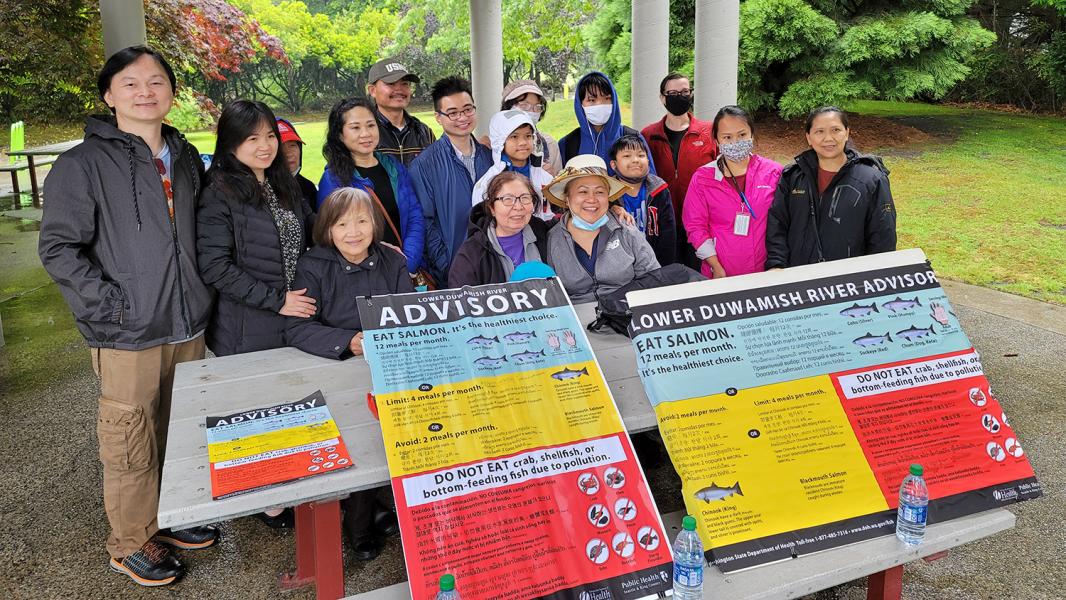
Improved signage for all
After learning that people were still crabbing on the Duwamish River at the fishing pier at t̓uʔəlaltxʷ Village Park and Shoreline Habitat (formerly known as Terminal 105 Park), Port staff reached out to Public Health and the CHAs to develop more effective advisory signs that would deter people from fishing and crabbing of resident species from the Duwamish River.
To gather input on the signs, CHAs tapped into their communities to recruit participants and provided in-language interpretation. During focus group sessions, fishers provided direct input on where the signs should be placed and how the signs could effectively deter people from fishing and crabbing from the Duwamish River. Public Health and the Port facilitated several in-language focus groups, and Public Health provided gift cards for the participants. Through this process, Port staff learned that the one existing sign was too small, hidden out of plain view, too wordy and hard to understand. Now there are two larger reoriented signs with simplified messaging translated to Vietnamese, Khmer, and Spanish, Korean, Chinese, Russian, Laotian, and Somali.
Joanna Florer, Senior Environmental Program Manager at the Port of Seattle, attended the focus group session to collect input on the fish warning advisory signs. Based on feedback, she learned the most important “Do Not Eat” message applying to shellfish, resident fish, and crab should be positioned at the top of the sign. Participants also requested signs with fewer words and more imagery, which led the Port to create another small red advisory sign with only images and no text.
“It was a fun, engaging, and collaborative process. I learned a lot because community members mentioned things that never even dawned on me,” Florer said. “Fishing community members were really happy to have the opportunity to provide the feedback and mentioned that it meant a lot to them that the Port created the opportunity that reinforced that their input was valued.”
Now, redesigned fish advisory signs are being installed at other Port parks along the Duwamish, starting with t̓uʔəlaltxʷ Village Park and Shoreline Habitat, and will eventually be posted at all Port shoreline access points along the Duwamish River.
The Port provided Public Health with a new graphic, developed through the community engagement process, that can be shared with other property owners along the Duwamish River. The new design is also being used by the City of Seattle at the Spokane Street fishing pier. This is just one example of the Port working with the community to ensure that fishing on the Duwamish River is safe and fun, and demonstrates our commitment to community engagement and equity.
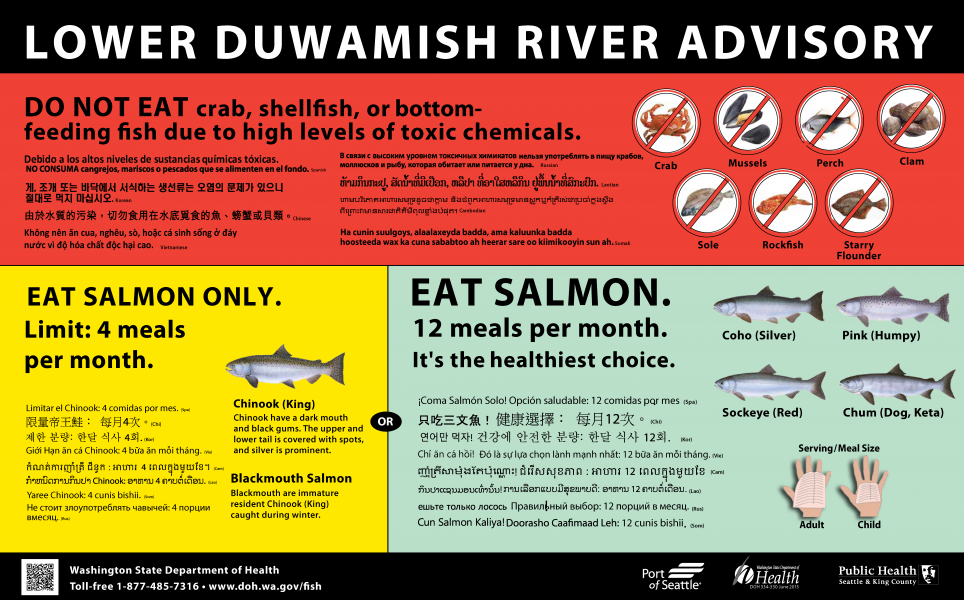
To request a sign, contact Khanh Ho, Program Lead at Public Health — Seattle and King County at (206) 263-0906 or [email protected].
Learn more about the Community Health Advocates and Fun to Catch, Toxic to Eat program

